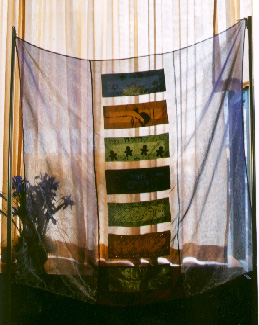
GILDA SPINAT DESCRIBES THE HUPPAH:

GILDA SPINAT DESCRIBES THE HUPPAH:
I want you know the background for the creation of the huppah. First and foremost, you should know that it was made with love. Andy and Neal knew about the quilt which I had recently finished, and asked if I would sew the huppah for them. I was flattered and honored by this request. These are my nephews and they are very special people. I loved working with the fabrics and seeing it all come together into a stunningly gorgeous huppah. †And, I was inspired by all of the work and thought put into the creation of the huppah by so many of the people who love Andy and Neal.
Andy and Nealís friend, Ellen Wertheim, who is a fabric artist specializing in Judaic synagogue art, designed the huppah. She and Neal chose and bought the fabric. Andy and Neal asked their sisters and some of their friends to create representations of the sheva berachot on 7 separate pieces of silk shantung. The background panels, which were silk organza, and the 7 blessing panels were sent to me and I sewed everything together.

MARJORIE INGALL DESCRIBES HER HUPPAH PANEL:
FAMILY
This panel shows a tree, growing from the right side of the panel toward
the left (the direction that Hebrew reads), growing ever more abundant
and leafy. This strong and healthy tree is coming from a stylized river
(BLOOD? water?) indicating that BLOOD and NOT-BLOOD can mingle with great
joy, growing great things. Despite my father's biases to the contrary.
:)
IRYS & CHANA DESCRIBE THEIR HUPPAH PANEL:
JOY AND GLADNESS (SASSON V'SIMCHA)
For our huppah panel we created a bas relief of the Hebrew words 'sasson
v'simha.' Using the fabric of the test panel we cut out the Hebrew
letters
and built up each successive layer by applying the gold paint, which
acted as
an adhesive in addition to a pigment.
The Hebrew words for 'joy and gladness' arise in the frame of the panel
immersed in and surrounded by a golden surface. Our idea is that even
though
it may sometimes appear to be hidden, the opportunity for joy and gladness
is
always present and that happiness is a shimmering sea of possibilities...
Irys Schenker
Chana Pollack
RENEE RIVERA & JENNY WORLEY DESCRIBE THEIR HUPPAH PANEL:
LOVE AND COMPANIONSHIP
This panel consists of the phrase, "Where you go, I will go", derived
from the Book of Ruth in which Ruth says to Naomi, "Entreat me not to leave
thee, or to return from following after thee: for whither thou goest, I
will go; and where thou lodgest, I will lodge: thy people shall be my people,
and thy God my God." The use of gold and silver studs refers to the
Song of Solomon: "We will make thee borders of gold with studs of silver."
The rhinestones adorning the panel represent "flamboyant, blasphemous queer
revisionism."
TRACEY DIAMOND (with the help of Amie and Allison) DESCRIBES THEIR HUPPAH PANEL:
COMMUNITY
This panel shows the Hebrew word for community, kehila, above
a drawing of the world, and alternating figures, black and white, holding
hands, depicting community on a larger scope: people of all religions,
nationalities, races and cultures, living in peace and harmony; accepting
each others' differences and learning from one another. Flowers at
the bottom signify beauty and happiness.
BARRIE STACHEL (with the help of Paul, Samantha, and Andrew) DESCRIBES THEIR HUPPAH PANEL:
TRADITION AND REINVENTING RITUAL
This panel shows the setting or rising sun with four stars in the sky
above it, symbolizing the beginning of a new day or a new holiday, with
the continuing potential to create new rituals or entwine these new rituals
with older traditions. The stars are the light that help illuminate the
sky when the sun goes down, indicating that there is always light if we
look hard enough. Another interpretation of the panel is that it represents
the Valley of the Sun and the four stars are the Stachel family.
ELLEN WERTHEIM DESCRIBES HER HUPPAH PANEL:
LEARNING AND CREATIVITY
This panel starts with the Hebrew letter, Aleph. The Aleph is the beginning,
the sound of the creative breath. From this beginning all is fashioned,
as in the space and stars of the panel. The Aleph curves and moves within
this space. The vertical lines represent the formation of order, harnessing
creative energy to form the pages of a book. The vertical plane, on the
upper left of the panel, moves us upward, seeking; learning.
SUSAN HICKS DESCRIBES HER HUPPAH PANEL:
JUSTICE AND COMPASSION
Because justice and compassion are so intertwined conceptually, this panel attempts to weave them visually. By utilizing both symbol and word, and varying degrees of opacity and shimmer, the emphasis shifts at the whim of the viewer. Justice and compassion appear to alternate from foreground to background. Although visually framed, image periodically exceeds boundary in an effort to describe the need for justice and compassion to inform all action.
